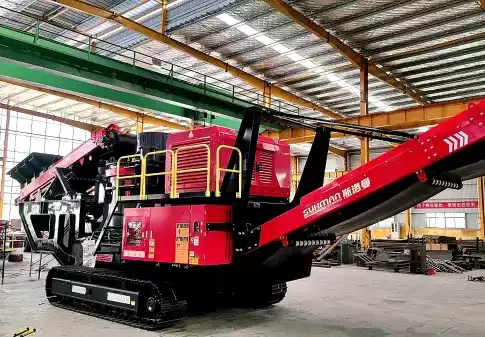Table of Contents
- Introduction to Grinding Methods
- Jaw Crushers: Overview and Operation
- Construction of Jaw Crushers
- Key Characteristics and Calculations
- Technical Proposals for Jaw Crushers
- Contact Dainamu
Introduction to Grinding Methods
Grinding is a fundamental process in material processing, and its methods are categorized based on the hardness of the material being processed: hard, medium-hard, and soft. The choice between crushing (performed by crushers) and milling (performed by mills) depends on the average grain size of the material.
The following table outlines the primary grinding methods, the resulting product grain sizes, and the machines typically used for each category of material hardness:
| Grinding Method | Type and Size (mm) of Product Grains | Machines for Hard Materials | Machines for Medium-Hard and Soft Materials |
|---|---|---|---|
| Coarse Crushing | Large pieces >50 mm | Jaw and cone crushers | Hammer crusher |
| Fine Crushing | Small gravel 5-50 mm | Cone and roll crushers | Roll crusher |
| Coarse Grinding | Gravel, "seed" 0.5-5 mm | Hammer crusher, roll mill | Attrition and rod mills |
| Fine and Ultrafine Grinding | Flour, powder 0.05-0.5 mm / 0.005-0.05 mm | Attrition, pin, and cone mills | Attrition, knife, and vibration mills |
| Colloidal Grinding | Colloidal powder <0.005 mm | Ball and jet mills | Ball and vibration mills (for wet grinding) |
In many scenarios, reducing large material pieces to fine powder in a single step or machine is either impossible or highly inefficient. As a result, multiple grinding machines are often integrated into a single system to achieve the desired outcome. During each grinding stage, a mixture of fine and coarse fractions is produced, necessitating the use of classifiers to separate these fractions based on grain size.
Grinding generates significant dust, so all grinding machines and their discharge paths are designed as closed systems. The outgoing air is cleaned using filters and cyclones to minimize environmental impact and ensure operational safety.
Jaw Crushers: Overview and Operation
Crushers are the most effective machines for the coarse grinding of large material pieces, capable of reducing them to particles as small as 5 mm. Among these, jaw crushers are distinguished by their two "jaws"—one fixed and one moving—which alternately decrease and increase the gap between them to crush materials.
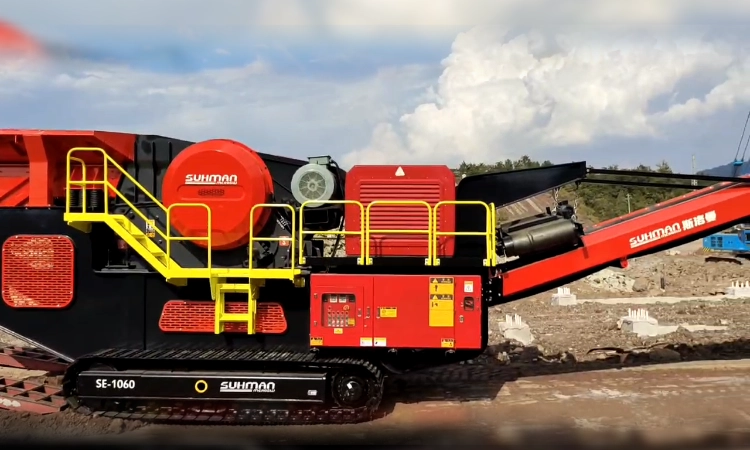
Large pieces of material enter the working space between the jaws and are crushed as the moving jaw approaches the fixed one. When the moving jaw retracts, the crushed material falls downward, allowing larger pieces to reposition for further crushing. Material is fed from the top, sliding between the jaws. By adjusting the gap width and the frequency of jaw movement, operators can control the final grain size and throughput of the crushed product.
Jaw crushers are versatile machines ideal for preliminary crushing of a wide range of materials. They operate by compressing the material between a fixed jaw and a moving jaw mounted on a connecting rod, with the crushed product discharged during the moving jaw’s reverse stroke.
Depending on the mounting of the moving jaw, jaw crushers are classified into three types:
- Greatest swing at the discharge slot (bottom): Maximizes movement at the outlet.
- Greatest swing at the feed opening (top): Enhances initial crushing capacity.
- Uniform movement of the moving jaw: Ensures consistent crushing across the jaw length.
Construction of Jaw Crushers
Let’s explore the construction of a jaw crusher with the greatest swing at the discharge slot as an example. All components are housed within a robust cast iron frame, mounted on a sturdy brick or concrete foundation. For larger machines, the frame is sectional, constructed from cast steel or thick steel plates (25-50 mm) welded together to withstand heavy loads.
Crushing occurs in the working space between the fixed and moving jaws, both of which are protected by removable ribbed plates made of special steel. The moving jaw, suspended on a fixed axis, oscillates via an eccentric shaft connected by a rod and toggle plates to adjustment wedges. The discharge gap width, which determines the degree of crushing, is adjusted by moving these wedges using bolts. A tie rod and springs facilitate the reverse movement of the jaw.
The toggle mechanism, comprising the rod and toggle plates, forms the core of the crusher’s design, enabling it to generate immense pressure. Jaw crushers are characterized by the dimensions of their feed and discharge openings. The jaws, being the most wear-prone components, are made from durable, replaceable materials. The material choice depends on the crushed material: softer materials use chilled cast iron, while harder ones require chrome or manganese steel.
Jaw surfaces can be ribbed or smooth. Ribbed jaws are suited for coarse crushing of hard materials, while smooth jaws are used for fine crushing of brittle materials. The toggle plates, operating under compression, are typically made from steel or cast iron with chilled ends. One toggle plate is designed to break if an excessively hard object (e.g., a metal piece) enters, serving as a safety mechanism.
Jaw crushers are renowned for their reliable construction and ease of maintenance. Key advantages include the opening of the discharge slot during the reverse stroke, a compact design, and the ability to quickly replace worn parts. Manufacturers like Dainamu offer a wide range of jaw crushers, from small laboratory models with a 150x100 mm feed opening to large units with a 2100x3000 mm opening, capable of processing up to 2,500 tons per hour with drive powers up to 400 kW.
For advanced solutions, check out Dainamu’s mobile jaw crushers for hard rock.
Key Characteristics and Calculations
A critical characteristic of a jaw crusher is the nip angle (α) between the moving and fixed jaws. If the nip angle is too large, material may be ejected from the feed opening; if too small, the crushing degree is insufficient due to the jaws’ proximity.
To ensure material remains in the working space, the nip angle should not exceed twice the friction angle (2φ). With a typical friction angle of 17 degrees (tan φ = 0.3), the maximum nip angle is 34 degrees, though practical designs range from 15 to 25 degrees.
In crushers with a crank mechanism, the number of oscillations equals the number of double swings, while in cam-driven crushers, it is half that number. Let’s define:
- α – nip angle
- h – height of the material layer in the working space (cm)
- e – minimum discharge opening size (cm)
- S – stroke of the moving jaw (cm)
- e + S – maximum discharge opening size (cm)
- K – number of double swings per minute
Assuming linear movement of the moving jaw (constant α), when the jaw retracts by S, a material layer of height h = S / tan α cm falls through the discharge opening. For this layer to exit, the stroke duration must be at least the time τ for the material to fall under gravity from height h: τ = √(2h / g) seconds, where g = 981 cm/s².
The stroke duration at K double swings per minute is τ = 60 / (2K) seconds. Equating these, we get K = 30 / √(2h / g). Substituting h, K_max = 665 √(tan α / S), the maximum allowable swings. Exceeding this prevents material from exiting fully. In practice, K = (600 ÷ 630) √(tan α / S).
Power consumption is approximated by N = (a * b) / 60 hp, where a and b are the length and width of the working space in cm.
Technical Proposals for Jaw Crushers
Jaw Crusher with 186 kW Power
Description:
- Steel frame with stiffeners
- Monoblock steel connecting rod
- Heat-treated forged alloy steel eccentric shaft
- Tapered roller bearings
- Replaceable manganese steel jaw liners
- Steel jaws
- Manual hydraulic toggle adjustment
- Two flywheels, one with V-belt grooves
- V-belt drive with motor pulley and five V-belts
- High-torque motor: 186 kW, 1200 rpm
Specifications:
- Feed opening: 915 x 1270 mm
- Required power: 186 kW
- Flywheel speed: 220 rpm
- Moving jaw length: 2187 mm
- Fixed jaw length: 1936 mm
- Shaft diameter at center: 457 mm
- Shaft diameter at eccentric bearings: 410 mm
- Shaft diameter at frame bearings: 305 mm
- Approximate weight: 40 t (standard toggle), 41 t (hydraulic toggle)
- Discharge gap: 76 – 280 mm
- Shaft eccentricity: 19 mm
- Toggle throw: 38 mm
- Flywheel diameter: 1524 mm
An automatic lubrication system supplies filtered oil to each bearing, with controlled flow, including a low oil pressure alarm, 75.7 L reservoir, 1.9 L/min pump (0.56 kW), 380 V motor, flow regulator, pressure gauge, piping, and immersion heater.
Jaw Crusher with 6 t/h Capacity
Technical Data:
- Type: Jaw crusher
- Dimensions (L x W x H): 147 x 126 x 113 cm
- Weight (without motors): 2200 kg
- Max power: 18.5 kW
- Max shaft speed: 430 rpm
Materials:
- Frame: Welded Fe 430-B sheet
- Jaw holder: Cast FeG 520 steel
- Shaft: 39 NCD3 alloy steel
- Jaws: XG 120 manganese steel
- Side walls: XG 120 manganese steel
- Flywheels: G 25 cast iron
- Toggle mechanism: G 25 cast iron
Performance:
- Feed opening: 450 x 160 mm
- Max feed size: 120 mm
- Max theoretical capacity: 11 t/h
- Discharge adjustment: 10-30 mm
- Noise level: 70-80 dB(A)
Equipment Offered: Jaw crusher with 6 t/h capacity, adjustable discharge (0-30 mm), 18.5 kW motor, 450x150 mm feed opening, max feed size 120 mm, shaft speed ~400 rpm. Crushing parts made of manganese steel. Note: Capacity varies with material and settings; testing is advised.
Description: Material enters via the top, is crushed between moving and fixed jaws, and exits through an adjustable discharge. The crusher features a ribbed frame, jaws, shaft, flywheels, and adjustment mechanism. Learn more about dual-core jaw crushers.

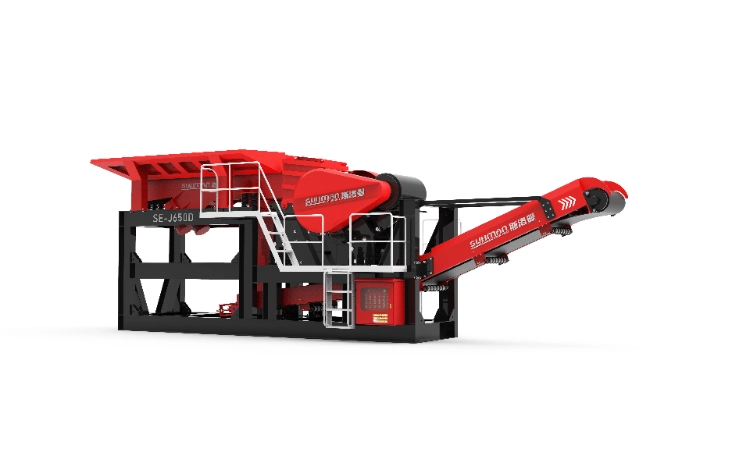


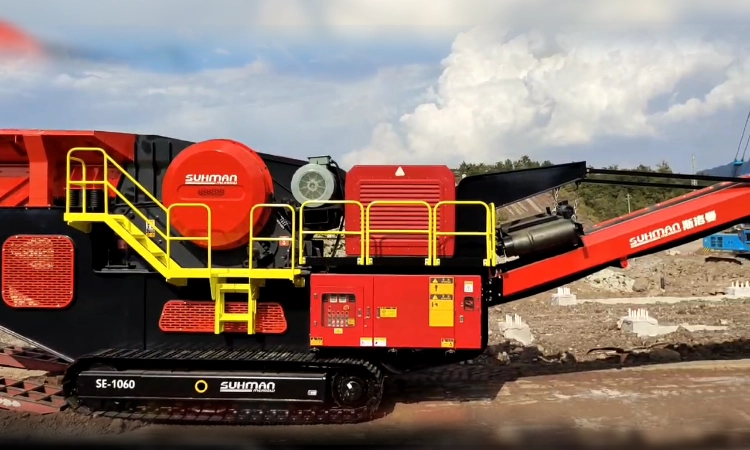
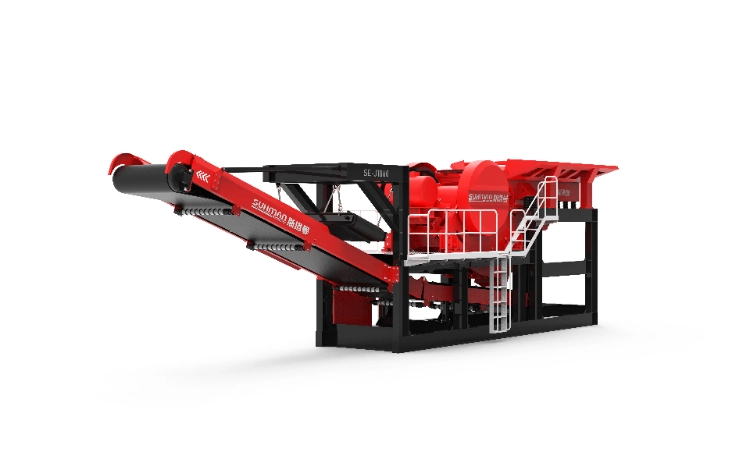
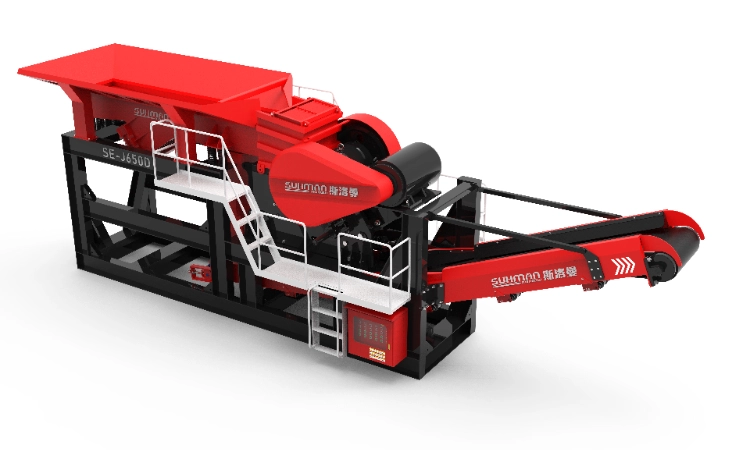

Jaw Crusher for Coal and Coal-Stone Mixtures
Basic Information:
- Raw material: Coal, coal-stone mixture
- Capacity: 400-800 t/h
- Max feed size: 1000 mm
- Output size: 150-300 mm (adjustable)
Introduction: Typically used as a primary crusher in quarry lines, ore crushing plants, and powder-making facilities, this jaw crusher is vital in mining, construction, concrete recycling, hydropower, and infrastructure projects.
Features:
- Simple structure, easy maintenance, stable performance, high capacity
- Uniform final particles with a high crushing ratio
- Advanced manufacturing technology and high-quality materials
Main Components:
- Flywheel
- Upper cheek plate
- Fixed jaw plate
- Frame
- Lower cheek plate
- Tension rod
- Eccentric shaft
- Moving jaw
- Moving jaw plate
- Adjustment device
- Toggle plate
- Spring
Technical Data:
- Feed opening: 1200x1500 mm
- Max feed size: 1020 mm
- Discharge range: 150-300 mm
- Capacity: 400-800 t/h
- Motor power: 200 kW
- Weight: 100.9 t
- Dimensions: 4200x3750x3820 mm
Materials:
- Main unit: Q235 steel
- Main shaft: 40CrMo
- Jaws: Manganese alloy
- Cavity shape: V-type
- Toggle plate: Single
- Surface: Sandblasted and painted
- Protection: Spring and hydraulic release
- Lubrication: Grease
Operating temperature: -30°C
Service life: 10 years with proper use.
Jaw Crusher with up to 1800 t/h Capacity
Description: This jaw crusher integrates cutting-edge global crushing technologies and research, designed using finite element analysis to represent the pinnacle of jaw crusher engineering.
Compared to traditional models, it emphasizes detail, using high-strength materials and advanced manufacturing for superior performance, reliability, and efficiency.
Features and Benefits:
- High-Strength Design: Available in welded or modular frames. Welded frames feature rounded transitions to reduce stress, while modular frames use a non-welded design for easy transport, ideal for underground or high-altitude mines.
- Optimized Feeding: Symmetrical V-shaped chamber with a large toggle angle and long stroke for better feeding, higher output, and reduced wear.
- Durability: Heavy-duty eccentric shaft, high-quality roller bearings, and optimized design ensure impact resistance and stability. Labyrinth seals and centralized lubrication maintain clean operation.
- Protective Shield: A rigid shield protects the moving assembly from material impact.
- External Bearing Support: Cast bearing housings integrated with the frame avoid radial loads, ensuring smooth operation.
- Convenient Adjustment: Mechanical or hydraulic discharge adjustment is simpler and faster.
- Integrated Motor Mount: Saves space and extends belt life with adjustable tensioning.
- Vibration Absorption: Rubber dampers reduce foundation stress by absorbing vibrations.
Technical Specifications:
| Type | Feed Opening (mm) | Discharge Range (mm) | Capacity (t/h) | Motor Power (kW) | Weight (kg) |
|---|---|---|---|---|---|
| 1 | 510x800 | 40-150 | 50-300 | 55-75 | 9240 |
| 2 | 600x1020 | 60-175 | 85-400 | 75-90 | 16600 |
| 3 | 760x1020 | 70-200 | 120-490 | 90-110 | 27500 |
| 4 | 850x1100 | 90-215 | 160-590 | 110-132 | 34550 |
| 5 | 950x1250 | 110-250 | 260-810 | 132-160 | 50700 |
| 6 | 1070x1400 | 125-250 | 360-900 | 160-200 | 60300 |
| 7 | 1100x1250 | 125-300 | 360-950 | 160-200 | 56100 |
| 8 | 1200x1500 | 150-350 | 400-1040 | 200-250 | 89100 |
| 9 | 1200x1600 | 150-350 | 500-1300 | 220-250 | 88400 |
| 10 | 1500x1800 | 160-380 | 600-1500 | 315-400 | 120500 |
| 11 | 1800x2100 | 175-350 | 700-1800 | 355-450 | 180000 |
Explore Dainamu’s mobile crushing plants for advanced solutions.
Jaw Crusher with up to 500 m³/h Capacity
Description: Featuring a single toggle plate, this jaw crusher offers a wide crushing range, suitable for materials with a compressive strength up to 320 MPa, ideal for both primary and secondary crushing.
Features and Benefits:
- Simple, reliable construction with easy operation
- Low operating costs
Technical Specifications:
| Type | Feed Opening (mm) | Max Feed Size (mm) | Discharge Range (mm) | Capacity (m³/h) | Motor Power (kW) | Weight (t) |
|---|---|---|---|---|---|---|
| 1 | 400x600 | 340 | 40-100 | 10-40 | 30 | 6.1 |
| 2 | 500x750 | 425 | 50-100 | 25-60 | 55 | 10.5 |
| 3 | 600x900 | 500 | 65-180 | 30-85 | 55-75 | 14.8 |
| 4 | 750x1060 | 630 | 80-180 | 72-150 | 90-110 | 28 |
| 5 | 800x1060 | 680 | 100-200 | 85-143 | 90-110 | 30 |
| 6 | 870x1060 | 750 | 170-270 | 145-235 | 90-110 | 28.5 |
| 7 | 900x1200 | 780 | 100-200 | 100-240 | 110-132 | 45.2 |
| 8 | 1000x1200 | 850 | 200-280 | 190-275 | 110-132 | 45.7 |
| 9 | 1200x1500 | 1020 | 150-300 | 250-500 | 200-220 | 89 |
| 10 | 250x1000 | 210 | 25-60 | 10-30 | 30-37 | 6.5 |
| 11 | 250x1200 | 210 | 25-60 | 13-35 | 37 | 7.7 |
| 12 | 300x1300 | 250 | 20-90 | 13-53 | 75 | 11.4 |
Jaw Crusher for Primary Crushing
Technical Specifications:
- Feed opening: 500x280 mm
- Motor: 11 kW – 400 V – 50 Hz – IP55
- Gap adjustment: 20 – 80 mm
- Rotation speed: 350 rpm
- Weight: 2,600 kg
Description:
- Welded thick-plate S235JR frame with a crushing chamber lined with manganese steel wear plates
- Eccentric shaft on oversized self-aligning bearings
- Connecting rod supporting the moving jaw, mounted on the eccentric shaft
- Jaws made from wear-resistant bimetallic sheet (12-14% Mn)
- Hydraulic suspension with cylinder, pump, buffer tank, and safety valves for protection against impacts
- Return mechanism with coil springs
- Heavy flywheel with V-belts for eccentric compensation
- Steel profile frame supporting the crusher and motor
- Control group: asynchronous three-phase motor, drive pulley, V-belts, protective covers, motor tensioning device
- Instrumentation: Rotation detection and limit switch for the moving jaw
Jaw Crusher with Belt Feeder
Technical Specifications:
- Material: Construction waste, concrete, natural stones (up to 100 MPa compressive strength)
- Belt feeder with hopper: 500 mm width, 0.55 kW electric drum, 0.2 m³ capacity
- Max feed size: 350x190 mm
- Gap setting: 10-45 mm
- Output size: 0-70 mm (adjustable)
- Capacity: 1.5-4.5 t/h
- Drive: 5.5 kW motor, 50 Hz, 3x400 V, 1450 rpm
- Total weight: 990 kg
Description: Designed for crushing small waste materials (plaster, brick, concrete), this crusher produces granules up to 70 mm for reuse. It includes a single-toggle jaw crusher, welded steel frame, lockable toolbox, and distribution board. The frame comprises two side walls, front and rear walls, and a tubular spacer. Fixed and moving jaws, cast from 12% Mn steel, are interchangeable and reversible.
The pendulum, driven by an eccentric spindle, is mounted on pivot bearings. Flywheels are at both ends of the eccentric shaft. The toggle plate requires no lubrication, and spherical roller bearings are sealed. Overload protection is provided by the toggle plate. The discharge gap is adjustable via shims. The crusher operates at -10°C and is fed via a belt conveyor with a hopper.
Contact Dainamu
For more information on our jaw crushers and other equipment, contact Dainamu, a leading provider in China, at anhuisiluoman@gmail.com. Visit our homepage or products category.





